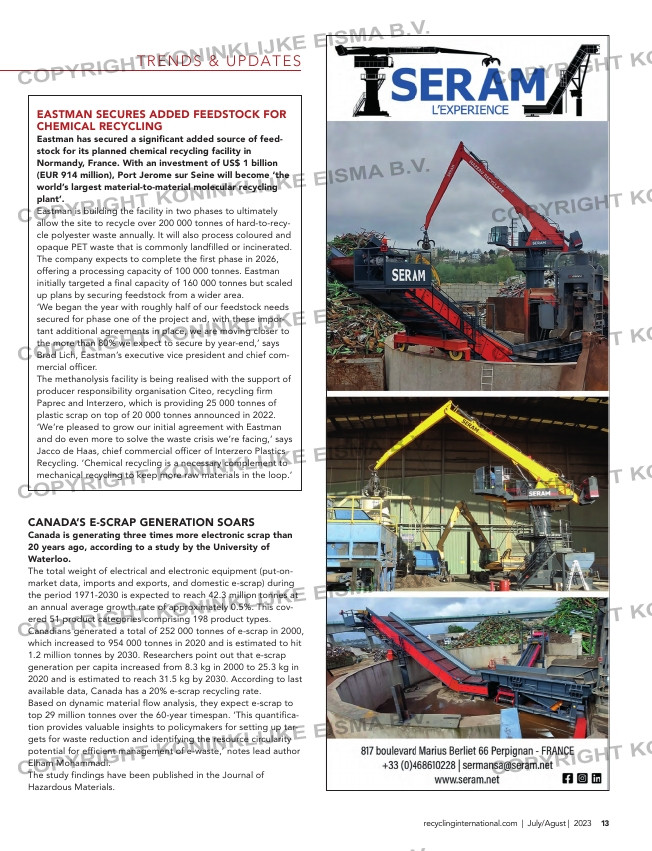Page 13 from: Recycling International – July/August issue 2023

TRENDS & UPDATES
13recyclinginternational.com | July/Agust | 2023
MARS TO SCRAP SHELL ASSET IN BRAZIL
The European division of Modern American Recycling Services (MARS) has formalised an agreement with Green Recycling to dis-
mantle a floating production storage and offloading unit owned by Shell Brasil Fluminense.
The oil and gas production asset, located in the Salema oil fields of Campos Basin, will be scrapped after being in service for over 20 years.
The structure is 390 metres long with a light displacement of 51 000 tonnes.
The two parties expect to sign the contract this year, covering engineering activities, preparation, dismantling and eco-friendly recycling of
the unit. The Fluminense unit is expected to arrive at the MARS yard in Frederikshavn, Germany, in 2024, after obtaining the required
approvals in compliance with local and international regulations.
EV BATTERIES OFFER BACK-UP SOLUTION FOR
STEEL MILL
Swedish steelmaker Björneborg is investing in a battery park
using reused batteries from end-of-life electric vehicles.
As well as improving the circularity of the forge operation, the
company says it will also support power peaks and provide a back-
up solution for any disturbances in the power supply. The Bless III
pack at the heart of the product is made by fellow Swedish opera-
tion BatteryLoop, a Gothenburg-based part of the Stena Metal
Group.
‘We have investigated different alternatives but concluded that
BatteryLoops’ concept was the absolute best solution,’ says
Björneborg ceo Håkan Dedorsson. ‘We can support the grid sta-
bility as well as avoid the worst peaks of electricity prices and get
a more predictable energy cost. By reusing electric car batteries,
we are also strengthening our sustainability concept and continues
our journey towards continuous fossil free and climate neutral pro-
duction in 2026 onwards.’
BatteryLoop ceo Rasmus Bergström says it is stimulating to work
with a company like Björneborg Steel. ‘Their focus on circularity
and quality makes the collaboration extra rewarding. This installa-
tion shows the benefit our energy storage systems can make in an
industry. Our system, including digital services, will both create
benefits locally for Björneborg Steel as well as positive effects
nationally.’
EASTMAN SECURES ADDED FEEDSTOCK FOR
CHEMICAL RECYCLING
Eastman has secured a significant added source of feed-
stock for its planned chemical recycling facility in
Normandy, France. With an investment of US$ 1 billion
(EUR 914 million), Port Jerome sur Seine will become ‘the
world’s largest material-to-material molecular recycling
plant’.
Eastman is building the facility in two phases to ultimately
allow the site to recycle over 200 000 tonnes of hard-to-recy-
cle polyester waste annually. It will also process coloured and
opaque PET waste that is commonly landfilled or incinerated.
The company expects to complete the first phase in 2026,
offering a processing capacity of 100 000 tonnes. Eastman
initially targeted a final capacity of 160 000 tonnes but scaled
up plans by securing feedstock from a wider area.
‘We began the year with roughly half of our feedstock needs
secured for phase one of the project and, with these impor-
tant additional agreements in place, we are moving closer to
the more than 80% we expect to secure by year-end,’ says
Brad Lich, Eastman’s executive vice president and chief com-
mercial officer.
The methanolysis facility is being realised with the support of
producer responsibility organisation Citeo, recycling firm
Paprec and Interzero, which is providing 25 000 tonnes of
plastic scrap on top of 20 000 tonnes announced in 2022.
‘We’re pleased to grow our initial agreement with Eastman
and do even more to solve the waste crisis we’re facing,’ says
Jacco de Haas, chief commercial officer of Interzero Plastics
Recycling. ‘Chemical recycling is a necessary complement to
mechanical recycling to keep more raw materials in the loop.’
CANADA’S E-SCRAP GENERATION SOARS
Canada is generating three times more electronic scrap than
20 years ago, according to a study by the University of
Waterloo.
The total weight of electrical and electronic equipment (put-on-
market data, imports and exports, and domestic e-scrap) during
the period 1971-2030 is expected to reach 42.3 million tonnes at
an annual average growth rate of approximately 0.5%. This cov-
ered 51 product categories comprising 198 product types.
Canadians generated a total of 252 000 tonnes of e-scrap in 2000,
which increased to 954 000 tonnes in 2020 and is estimated to hit
1.2 million tonnes by 2030. Researchers point out that e-scrap
generation per capita increased from 8.3 kg in 2000 to 25.3 kg in
2020 and is estimated to reach 31.5 kg by 2030. According to last
available data, Canada has a 20% e-scrap recycling rate.
Based on dynamic material flow analysis, they expect e-scrap to
top 29 million tonnes over the 60-year timespan. ‘This quantifica-
tion provides valuable insights to policymakers for setting up tar-
gets for waste reduction and identifying the resource circularity
potential for efficient management of e-waste,’ notes lead author
Elham Mohammadi.
The study findings have been published in the Journal of
Hazardous Materials.
10-11-12-13-14-15_trendsupdates.indd 13 05-07-2023 14:18



